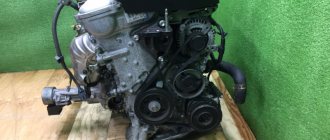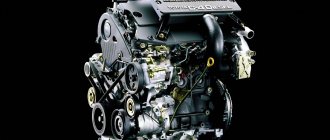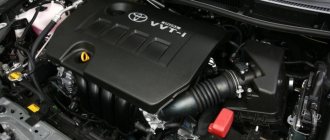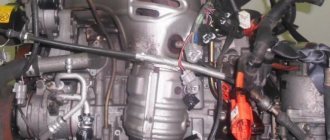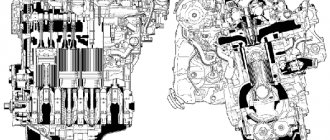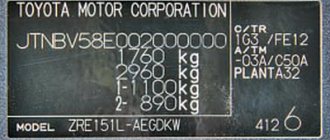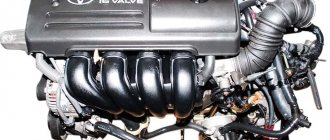3.5 liter engines produced by Toyota GR series, models FE, FSE, FXE, FKS, FXS, FZE, like the previous MZ series, petrol, six-cylinder, with a V-shaped aluminum cylinder block (three cylinders on the left and right) with a camber angle of 60°. The heads, also made of aluminum, each head has two solid cast camshafts with twelve valves. Fuel is supplied to the cylinders by an injector. The cylinder head has two intake and exhaust valves for each cylinder. The crankshaft and connecting rods are forged from high-strength steel. The intake manifold, like those of aluminum engines, has an ACIS system.
General technical characteristics of the Toyota 2GR-FE engine
| Production | Toyota factories:
|
| Serial production period | 2005 |
| Supply system | injector |
| Type | V-shaped |
| Located in the engine compartment | longitudinal |
| Number of cylinders | 6 |
| Valves for each cylinder, pcs. | 4 |
| Compression in cylinders, kgf/cm² | 13-14 |
| Main fuel used | gasoline from Oct. numbering 95 (in Russia 98) |
| Environmental friendliness | Euro 5 |
| Fuel consumption, l/100 km (example for Lexus RX 350): - in the city - on the highway - in general | 14.3 8.4 10.6 |
| Oil consumption, g/1000 km | up to 1000 |
| Engine oil | 5W-30 |
| How much oil is in the engine, l | 6.1 |
| Oil change carried out, km | 10,000 (better than 5000) |
| Timing drive chain resource, km | ≈300,000 or more |
| ICE resource, km |
| Engine model 2GR | Cylinder diameter x piston stroke, mm | Compression ratio | Power, hp /at rev. per minute | Torque, Nm/ at rev. per minute | Electronic fuel injection system | ||
| FE (basic) | 94.0 x 83.0 | 10.8 | 277 | 6200 | 346 | 4700 | EFI-L |
| 10.8 | 280 | 344 | |||||
| FKS | 11.8 | 278 | 6000 | 359 | 4600 | D-4S | |
| 311 | 6600 | 380 | 4800 | ||||
| 295 | 6300 | 362 | 4700 | ||||
| FSE | 11.8 | 306 | 6400 | 375 | 4800 | ||
| 315 | 377 | ||||||
| 318 | 380 | ||||||
| 296 | 368 | D-4S+H | |||||
| FXE | 12.5 | 249 | 6000 | 317 | |||
| 13.0 | 292 | 352 | 4500 | ||||
| 295 | 356 | ||||||
| FZE | 10.8 | 327 | 6400 | 400 | 4000 | EFI-L | |
Engine model 2GR-FE
The 2GR-FE motor is the base for subsequent models of motors in this series. It is designed for vehicles with front-wheel drive and all-wheel drive. The main parameters on which the power and speed of the engine depend are the internal diameter of the cylinders of 94 mm and the piston stroke of 83 mm. In terms of power and torque, the engine at a crankshaft speed of 6200 rpm can vary from 266 to 289 hp. and from 332 to 353 Nm, respectively, which depends on the models and modifications of engines made for specific cars.
All models of the 2GR engine, including the FE, use the Dual VVT-i gas distribution system; torque is transmitted from the crankshaft to the intake camshafts through a chain and from them through short chains to the exhaust camshafts. The camshaft cams have concave bases; it is this design of the cams that makes it possible to increase the valve lift, which differs from the conventional gas distribution system used on the 1GR-FE engine. The 2GR-FE engine weighs (on average) 163 kg.
Application of 2GR-FE
Toyota:
- Avalon GSX 30, from 2004 to 2012, GSX 40, from 2012;
- Aurion GSV 40, from 2006 to 2012;
- RAV 4/Vangard GSA 33/38, from 2005 to 2012;
- Estima/Previa/Tarago GSR 50/55, since 2006;
- Camry GSV 40, from 2006 to 2011, GSV 50, from 2011;
- Sienna GSL 20/23/25/30/33/35, since 2006;
- Corolla E 140/E 150, from 2007 to 2014;
- Highlander/Kluger GSU 40/45, from 2007 to 2014;
- Blade GRE 156, from 2007 to 2012;
- Mark X Zio GGA 10, from 2007 to 2013;
- Alphard/Wellfire GGH 20/25, since 2008;
- Venza GGV 10/15, since 2008;
- Harrier GSU 30/31/35/36, from 2007 to 2009;
- Aurion, from 2007 to 2009
Lexus:
- ES 350 GSV 40, from 2006 to 2012, GSV 60, from 2012, GGL 10/15/16, from 2009, RX 350 from 2007 to 2009
Lotus:
- Evora, 280 l. s., 350 Nm, on Sport Pack models the cutoff is increased to 7000 rpm, since 2009, GTE 470 hp. pp., ∗S since 2011;
- ∗Eksidzh S, 2012, 345 l. s., 400 Nm.
∗Turbocharged.
History of creation and production
For the first time outside Japan, car enthusiasts were able to enjoy the beauty of the Highlander's lines in the cradle of the world automobile industry, Detroit, in 2001. The car with a frame body, designed on the Toyota K platform, has three generations and several restylings.
Depending on the set of functions, it is available with five or seven doors.
Since 2008, the car platform has been as close as possible to another famous model - Camry. And a couple of years later, Highlender was officially sold in the Russian Federation for the first time.
It should be noted right away: despite the body design, the new car could not be called an SUV. Its main features:
Power plants consistently increased displacement and power - first 2.4 liters, then 3 and 3.5. The automatic transmission finally became five-speed.
A year before the start of production, modifications of the next generation Highlander were no longer sold in Japanese car dealerships. The main markets for it remained the USA, Canada, China, Mexico, Australia (the same Kluger) and New Zealand. The powerful 3.5-liter V6 engine is complemented by a newly designed hybrid engine with the same displacement. As an experiment, a front-wheel drive version of the car was produced with a four-cylinder 2.7-liter 1AR-FE engine and a six-speed automatic transmission.
Since 2010, in a new design look, Highlander began to rapidly conquer the market of Russia and Ukraine in the basic configuration at a price of 1.6 million rubles:
Two years later, the price was reduced by 200 thousand rubles. The new cars did not have a third row of seats and a three-zone climate control system. The roof rail for installing an additional luggage rack has disappeared. The seat trim material has also been simplified.
The sound of the new car has become significantly quieter, thanks to a 30% increase in the sound insulation area of the interior floor. The set of configurations includes only two modern 3.5-liter gasoline engines of different power. The less “strained” 2GR-FXS was installed so that buyers were able to pay less tax. The basic dimensions of the model have changed in comparison with the 2nd generation analogue:
It is noteworthy that it is impossible to officially test the Highlander for emissions: there are no retail chains selling the crossover in Europe. Therefore, Gorets cannot boast of EuroNCAP examination data. But with the level of operational safety in the car, everything is in perfect order. This is confirmed by a certificate issued by the American Institute for Highway Safety IIHS based on the results of comprehensive crash tests.
Motor model 2GR-FSE
The 2GR-FSE engine model with an electronic fuel injection system D-4S is used on Lexus: IS, GS 350, Toyota: Mark X and Crown cars. The peculiarity of the system is the combination of fuel injection from conventional injectors in the heads into each cylinder and distributed fuel injection into the intake manifold. With the use of D-4S, the likelihood of detonation decreased and productivity increased.
Typically, similarly designed engines with port injection use modified injectors and pistons to improve air flow in the cylinders, but not in the 2GR-FSE engine. The system ensures that an optimally prepared mixture of gasoline and air is obtained at low speeds with increased engine load, while at the same time, when operating at high speed modes, engine performance decreases. On the 2GR-FSE, the injection port provides an optimal fuel mixture with a standard piston design, resulting in increased power density and efficiency without the use of supercharging. At the same time, improvements in environmental friendliness were achieved. Motor weight 174 kg.
Application of the 2GR-FSE motor
Toyota:
- Crown Atlet GRS 184, 315 l. With. and 377 Nm at 4800 rpm, 2006, GRS 204, 2008;
- Crown Hybrid GWS 204, 2008;
- Mark X GRX 133, 318 HP With. and 380 Nm at 4800 rpm, 2009
Lexus:
- GS 350 GRS 191/196, 2005, 2011;
- GS 450h GWS 191, 2005;
- IS 300 GSE 37, 255 l. With. and 320 Nm at 2000-4800 rpm, 2015;
- IS 350 GSE 21/26/31/36, 2005; 2009, GS E31, 2013;
- RC 350 2014
GR series engines. New "quality" Toyota
One could expect anything from Toyota in the new century, but not million-dollar engines. But take and get the “eights” of the UR series, which, at least in versions with distributed injection, take good care of 500,000 km, while still being in decent condition. But this was an exception to the rule. And confirmation that from now on Toyota units will have a short resource and inherent problems, here are the V-shaped “sixes” of the GR line. Perhaps the most odious engines since the advent of the ever-memorable 3S-FSE. We consider all the variants of Gears and their disadvantages.
Both along and across
By the early 2000s, Toyota had accumulated as many as four series of 6-cylinder gasoline engines. In-line G and JZ, which were installed longitudinally on marques, Crowns and other mainly large sedans and coupes. MZ V-shapes, mounted transversely on cars using the Camry platform of different generations. And also VZ, which once existed on passenger cars, but in the latest and most voluminous modification it became the prerogative of pickup trucks and SUVs (Tundra, Surf, etc.), that is, it was again deployed lengthwise.
2.0-liter 1G-FE, 3.3-liter 3MZ-FE and 3.4-liter 5VZ-FEIt has long been necessary to bring order to this diversity. Moreover, none of these engines, despite the use of VVT-i, and in some cases direct injection, met promising environmental standards. Moreover, the resources for their modernization have already been exhausted. Toyota got down to business, taking into account the latest trends and the fact that one family of units will satisfy the demand for them from “front-wheel drive” and models with a longitudinal power plant, in particular jeeps and pickups. Obviously, development took place in the second half of the 90s. However, in terms of technical solutions, these are modern engines, which are still produced in their latest versions. And it is unlikely that a replacement will appear in the near future. At least the same V-shaped and six-cylinder.
The debutant was the largest engine in the family - the 4.0-liter 1GR-FE (240–249 hp), introduced in 2002. It was targeted to replace 5VZ. Therefore, it was installed exclusively longitudinally - on Prado, Hilux Surf/4Runner, Tundra, Tacoma, FJ Cruiser, Fortuner, TLC 70, in some markets even on the “200” and Hilux.
Naturally, a block with a 60-degree camber is made of aluminum without any options. However, on the MZ series it was made of the same material. However, according to the current fashion, the cooling jacket was made open.
Block 1MZ and 1GR
The camshafts are, of course, driven by chains. The inlets are one long, the exhausts from them are two short. In the valve drive, the 1GR has conventional pushers. There is a system for changing the geometry of the intake tract. Until 2009, the variable timing system only controlled the intake valves.
In 2021, this engine went through a modernization course, receiving clutches on the exhaust camshafts (up to 270 horsepower). But they turned out to be only a visible change. So, like all the others already presented by the G-Arms, the 4.0-liter engine acquired camshaft housings (beds) separate from the cylinder head. The oil cooler and filter were moved under the engine, and the latter became collapsible, with a replaceable cartridge. As on the UZ and UR, SAI (Secondary Air Injection) appeared - a secondary air supply system that works during cold starts. That is, in conditions of a rich mixture, it supplies air to the catalysts. Finally, plastic inserts were installed in the cooling jacket, distributing the flow of antifreeze differently. Below we will explain why.
Next (2003) the 2.5-liter 4GR-FSE (200–215 hp) was introduced. It was also located only longitudinally - under the hoods of the Mark X and Crown, as well as Lexus IS and GS. In fact, 4GR, which immediately had Dual VVT-i and, as follows from the index, only direct fuel injection, became a replacement for 1G and 1JZ. True, at the moment the unit remains only on IS. The GS and Mark X were discontinued, the Crown received a "four" instead of this "six".
In the same year, the family was diversified with the 3.0-liter 3GR-FE. Another year later - 3GR-FSE. Both of them were installed on the same models as the 4GR. But the first (up to 231 hp) with distributed injection was in circulation in the markets of the Middle East and Asian countries, in particular in China. For example, it was equipped with the Hongqi HQ3 executive sedan, essentially the same Crown. The “Six” with direct injection (256 horsepower; Dual VVT-i was equipped with both) was used in Japan, Europe and the USA.
3GR, by the way, also had spacers in the cooling jacket. Only a different shape compared to the 1GR, but with similar functionality - to direct the coolant somewhere and somehow.
In 2005, Toyota specially prepared a 2.5-liter 5GR-FE for China. It also had phase shifters on all shafts. However, despite the identical displacement, the engine was not obtained from 4GR. From the 3.0-liter 3GR, the cylinder diameter was retained, but the piston stroke was made shorter. The 5GR didn't last long on the Crown and Reiz, a Mark X clone.
The same 2005 gave the consumer another version of the Gia in terms of volume - the 3.5-liter 2GR, the most common. This is the only one of all our heroes that was located both transversely and longitudinally. A characteristic division - the FE version (from 249 to 318 hp) was prepared for the Camry and all other models that in one way or another used its platform or its elements: Avalon, Aurion, Estima, Highlander / Kluger, Mark X Zio, Alphard / Vellfire , Sienna, Venza, Lexus ES and RX. Also RAV4/Vanguard, Blade, Lotus Evora and Exige. In other words, 2GR-FE became the ideological heir to the MZ series.
The FSE modification (310–317 hp), offered in a longitudinal version, in most cases became the top engine of all those models that received 4GR and 3GR. In addition to them, it was installed on the Lexus RC, and with a drive compressor, which boosted this V6 to 360 “horses,” on the Mark X. However, in the factory version, the GRMN 2GR-FSE developed “only” 321 power.
This time FSE did not mean direct injection, but its combination with distributed injection, which Toyota received the marketing abbreviation D-4S. In addition, this engine had a higher compression ratio (11.8 versus 10.8:1).
The 2GR-FXE, which appeared in 2010, replaced the same FE engine in the RX and Highlander (245 hp) in a number of markets. And FSE on GS and Crown Majesta (292 power). That is, they placed it in the engine compartment as they wanted. Moreover, in the latter case, D-4S was available. Its common key feature was the ability to work on the Atkinson cycle. And the compression ratio was raised to 12.5:1 and 13:1, respectively.
In 2015, all versions of the 3.5-liter engine began to be replaced by the 2GR-FKS, which again could be located both transversely and longitudinally. The D-4S system is already without options; work on the Atkinson cycle is included. Power ranges from 278–315 hp. And even Tacoma gets it, not to mention all sorts of Camry, Avalon, Alphard, ES, etc.
Finally, in the same 2015, the RX and Highlander received 2GR-FXS (310–312 hp), which is a version of the FKS for operation as part of a hybrid power plant.
Despite the emerging transition to “fours,” Toyota still continued to develop the GR series. For example, in 2013, again for the Chinese market, it introduced the 6GR-FE. The same 1GR-FE with Dual VVT-i that the Coaster bus received.
The Chinese Prado in 2021, as well as the Hiace for Japan and other countries in Asia and the Pacific region, acquired 7GR-FKS in 2019. In fact, the same 2GR-FKS with combined injection and “double phases”, developing 276 forces.
The last in this family were shown 8GR-FKS (311 hp) and 8GR-FXS (295 hp). Again 3.5 liters, Atkinson cycle, high compression ratio, of course, combined injection and Dual VVT-i. But the clutches on the intake camshafts in this case are electrically driven instead of hydraulically driven. And FXS, by tradition, is an engine included in the Hybrid drive.
In general, while the GARs are in service and have no intention of retiring. On the contrary, Toyota plans to phase out the V8. And what should they be replaced with in pickups, SUVs (on the same upcoming TLC), large sedans and minivans, if not with a V6? So we will definitely live with these “sixes” for a decade or two. And even more so, GR will be relevant in the secondary market for a long time. What might its owners encounter and what should people considering buying a car with these engines know?
Annoying little things and a death sentence for the engine
Probably, of the modern ones, only German engines have such controversial ratings as the engines of the GR series. Someone scolds them, recognizing them as perhaps the most unsuccessful among Toyota gasoline ones. Others almost idolize him. They say, “of course, there are black sheep in the herd, but overall the units are great.” Or “all are not very good, but one among them is in the best old Toyota traditions.” And yet, for the most part, the most diverse sources of information are unanimous in their opinion - there are some problems throughout the entire family of units. For example, the sensitivity of oxygen sensors to the quality of gasoline is called. They say that one refill is enough to kill the lambda probes. Throttle valves are vulnerable to any dirt and must be cleaned supposedly every 30,000–40,000 km. The injectors also require a similar operation. Otherwise, both will fail.
The ignition coils are weak - naturally, they are individual. The phase shifters are strumming. The overrunning clutch in the generator pulley fails. Up to 100,000 km, the pump located in the camber of the block begins to leak. The joint between the cylinder head and the camshaft housing, as well as the connection between the block and the timing cover, loses its tightness. Engines readily “boil” and are afraid of overheating. Two rubber tubes burst - for the cooler and for the oil supply to the VVT-i couplings.
The main complaint against the GArs is that they are bullies. This is where there is no consensus. Some believe that out of the entire family, only a single engine is susceptible to them. And they call it either 2GR (3.5 l.) or 3GR (3.0 l.). Another point of view: “Any engine in the range can be annoying, but not the 4.0-liter 1GR.”
Let's figure out which of all this is true and which is fiction. The first opinion is an insider from the dealership service, therefore incognito.
— As for fuel quality and contamination, or even more so the failure of throttle valves, injectors and oxygen sensors, GRs are no different from other engines. Options with direct injection or combined injection, of course, depend more on the purity of gasoline. Moreover, in the latter case, even the nozzles located in the intake tract, that is, operating with lower pressure, wear out. But, firstly, this is not widespread. Secondly, I have never encountered critical wear on a high-pressure fuel pump. That is, they came across moderately worn ones. However, they still provided normal spray.
The pump may leak from 60,000–70,000 km or closer to 100,000 km. Oil leaks out from under the timing cover. It's difficult to predict mileage here. Apparently, it depends on the quality of the sealant applied in the factory. Somewhere this can happen quite early. Some people don't have it at all. In any case, leaks from there are not an endemic phenomenon. As well as from under the valve covers, which relatively recently became plastic. And at the junction of the camshaft housings with the cylinder heads.
Phase shifters - yes, they strum. This usually does not lead to any consequences. And yet I know of one case when the clutch untwisted, that is, disassembled, and the valves met the pistons.
Perhaps all engines have gone through a series of service campaigns. Some had the goal of eliminating possible problems preventively. For example, on FSE modifications they changed valve springs, which theoretically could have broken. Replaced fuel sensor seal. In other cases, they eliminated what really failed. For example, an overrunning clutch in a generator pulley. In 2012, the pulley was modernized, but the coupling in it continued to fail. But the new type of ignition coils, which were switched to in 2001, are definitely better than the old ones, which burned out in droves after 140,000–150,000 km.
The rubber tubes of the oil circuits tore only on the 3.5-liter “transverse” 2GR-FE. On other motors, all-metal ones were immediately used. But there were a huge number of cases when the engine found itself without oil. Moreover, the pressure lamp, as a rule, did not light up. The owner understood that something was wrong with the engine when the check engine flashed - due to lack of oil, the phase shifters stopped working. The consequences were different. If I noticed in time - say, stains on the asphalt - it might not lead to oil starvation. More often than not, the engine came to an end - and scuffs appeared, and the liners got stuck.
However, bullying for no reason is the main fault of the Gears. I can’t speak for engines that have appeared in the last three to five years - there are not enough statistics on them yet. However, previous engines suffer from them. Except that I didn’t come across a 1GR with scuff marks. And everyone else - constantly. Moreover, the division here is as follows: on units located transversely, the first cylinder lifts up. On the “longitudinal” - the fifth. I can’t give any clear explanation for this - either ceramic dust is to blame, or some miscalculations in the cooling system and local overheating. Let me just say that something like this could easily happen at 150,000 km. Maximum at 180,000. I know of the only case when 2GR-FE lasted up to 300,000 km, and there were no signs of wear. But engines with seizures... Count them all!
It turns out that engines, which, in general, do not have the most serious shortcomings in modern times and an impressive timing drive resource (they somehow changed the chains at 300,000 km - the long one turned out to be elongated by less than half a link), are limited due to wear on the cylinder walls. such a mileage.
What’s interesting is that there may be no oil consumption on G-Ars before scuffing appears at all. When it starts to pick up, few people pay attention to the “oil burn” - the engine really stalls at idle. True, you can move at speed. One owner used this. Until the piston rings were torn out of their grooves and crushed in the cylinders. So when buying a car with GR, you need to check the corresponding cylinders. Although the first one on the transverse ones is difficult to access - you need to remove the collector. Fifth on the longitudinal ones - quite. Their condition will be visible already from the candle - from the characteristic velvety soot on it. Additionally, it is worth measuring the compression or looking inside with an endoscope. But the scanner, if the compression is above 8 kg/cm² (already worn out!), will not show this situation.
The 1GR, which can last up to 400,000 km, has a different problem. I omit the failure of SAI - it is suppressed and does not affect anything (see UR series). But the tendency to overheat is serious! It is enough not to update the antifreeze, not to clean the cooling system inside and out - and at one moment the gaskets in the area of the rear cylinders will blow out, and the heads will become warped. Why then are there channels between the cylinders? Why was the cooling jacket supplemented with inserts that direct coolant to the combustion chambers? Nothing helped - they kept boiling and boiling!
Regarding the restoration of the remaining “sixes”... Usually they are not capitalized. The repair, including the sleeve, costs more than 150,000 rubles. Contract units - 120,000. There are examples when 4GR from “right-hand drive” is installed on left-hand drive cars. It turns out cheaper.
Another opinion - with fundamental additions.
Roman Gyarvi
Private master
— The clutches rattle (especially when cold), the timing chains run for more than 300,000 km. The rubber parts of the oil circuits tear and the oil loss is not indicated by the pressure light. I witnessed a funny situation. A regular customer asked to change the line to metal. I called the dealers. They say they changed it. Well, yes - into your pocket! So it’s better to check for yourself, by car.
For engines and cylinders, everything is like this: on the transverse ones, the first one lifts, on the longitudinal ones, the fifth one. However, in the first case, I had to deal with scuffing in both the third and fourth cylinders. Moreover, in the fourth one the valves also burned out. Why, why, I won’t say. But there is this observation: Camrys with a mileage of 200,000–250,000 km have been encountered more than once with the same 2GR-FE. In the sedan, scuffing appeared only at such values. And crossovers (RX, Highlander), which are heavier, came to us with mileages of 150,000 or under 200,000 km.
I didn’t come across 1GR with scuff marks. However, the 4.0-liter V6 readily overheats. Also a mystery. Cavitation forms in the cooling system, or what? Other motors in the family are not prone to overheating. Although the same 2GR-FE of one of the clients siphons coolant opposite the fifth cylinder. There are no other signs of a broken gasket, and it drives like that.
The cost of restoration is more than 150,000 rubles. Expensive, so they choose to replace the entire unit.
This is the clinical picture. It would seem that, by modern standards, there are few minor faults that do not become critical. And at the same time, there are a couple of fundamental shortcomings that can result in significant amounts. By the way, despite the fact that both of our consultants dismissed all complaints about 1GR regarding bullying, there is information that they still appear in it. Both from mechanics and directly from owners. We won't say anything about the reasons. In the end, the bullies in other representatives of this line are inexplicable. In any case, it is worth checking it when purchasing. And buying cars with all these 2GR, 3GR, 4GR must, of course, take into account the likelihood of a subsequent engine rebuild or replacement.
Motor model 2GR-FXE
The 2GR-FXE engine model is a motor with a simulated Atkinson cycle, with its characteristic modified stroke duration, among which intake and compression are shorter, power stroke and exhaust are longer. It also has Variable Valve Timing (DVVT-i) and Exhaust Gas Recirculation (EGR) system.
Application of 2GR-FXE
Lexus:
- RX 450h GYL 10/15/16, (injector), 245 hp, 2010;
- GS 450h GWL 10, with D-4S (indirect and direct injection) 292 hp, 2012;
Toyota:
- Highlander Hybrid, without D-4S (injector) 245 hp, 2010;
- Crown Manjesta, 2013
Motor model 2GR-FKS
The design of the 2GR-FKS engine is based on the D-4S system from 2GR-FSE with all the kit necessary for its operation according to the Atkinson cycle, which are used in the 2UR-GSE and 8AR-FTS engines. The VVT-iW system is installed on the intake camshafts, and VVT-i on the exhaust camshafts, which ensures a transition to an economical mode at low loads.
Application of 2GR-FKS
Toyota:
- Tacoma GRN 305/310/325/330, 2015
Lexus:
- GS 350 GRL 12/16, 2015;
- RX 350 GGL 20/25, 2015
ICE 2GR-FXS is a hybrid version of 2GR-FKS. It was installed on a 2015 Lexus RX 450h (GYL 20/25).
The ideal choice of engine for Prado
As for choosing the best Toyota internal combustion engine for Highlanders, you should choose the powerful engine from the series that replaced the MZ, which was already outdated by that time. We are talking about a 3.5 liter 2GR-FKS petrol engine with a power of 295 hp. This example has been rolling off the assembly line for only three years, and is packed to the brim with the most advanced innovations in the engine industry. Like the already mentioned 2GR-FXS, the operation of this engine is based on taking advantage of the Atkinson cycle.
Combined fuel injection works in conjunction with other electronic devices that ensure the smooth functioning of the Atkinson cycle. The two camshafts have separate valve timing systems:
The ACIS unit is responsible for monitoring changes in the geometry of the intake manifold. Its use made the operation of the motor at various phases of movement more elastic and soft.
Maximum power of 295 hp. achieved at 6300 rpm. Fuel consumption is kept at a very low level:
We must understand that the shortlist of questions has not yet been fully formed.
During operation, few drivers of those who were the first to purchase a Highlander in the XU50 configuration after the 2016 restyling managed to wind the 250-300 thousand km required for serious analysis onto the speedometer. So far, the statistics of negative reviews related to inconvenience of use are as follows:
There is a lot of work for engine manufacturers in terms of modernization. But otherwise, the 2GR-FXE remains one of the best. It is actively used for installation on two popular Lexus models – GS 350 L10 and LS350 FX50. One must think that there will also be a place for it under the hoods of powerful new Toyota products in the future.
Source
Weaknesses of the 2GR engine
- DVVT-i system;
- Water pump (pump);
- Ignition coils;
- CPG;
- Cooling system radiator;
- Throttle valves;
- Fifth cylinder (on 2GR-FSE).
Composition of the timing drive of the DVVT-i system: 1 - VVT exhaust valve; 2 — VVT intake valve; 3 — camshaft position sensor (exhaust valves); 4 — camshaft position sensor (intake valves), 5 — coolant temperature sensor; 6 — crankshaft position sensor.
The DVVT-i system has its own life of flawless operation, and after its end, problems with the operation of the motor begin. DVVT-i is a timing chain drive that operates intake and exhaust camshafts with VVT mechanisms on both heads. VVT phase change mechanisms (clutches, also known as phase regulators) at the inlet and outlet differ in design by slight differences. The clutches are attached to the camshafts with five bolts. With the wear of parts of VVT-i mechanisms operating in constant friction, despite constant flows of engine oil, defects appear on the planes of the parts: increased roughness and non-flatness, marks, grooves, stepped transitions. Due to uneven wear across the thickness of the mating parts in the couplings (body, rotor, retainer, sprocket), jamming may occur in the operation of the phase regulators, which immediately disrupts the valve timing, that is, the intake and exhaust valves begin to open and close incorrectly. For the same reason, the VVT-i valve (solenoid) “ends” and it loses its ability to operate continuously (sticks). In addition, a clogged VVT-i valve oil filter mesh is often the cause of system malfunction. You can read below in the disadvantages what happens to the engine if there are problems in the VVT-i system.
The water pump (pump) has a resource of 50 - 70 thousand km. When the specified operating time is reached, the pump does not ensure the tightness of the coolant and it leaks. The defect is eliminated by replacing the unit.
Idling. A common defect on Japanese engines is caused by clogged throttle valves. With periodic maintenance of the dampers, problems do not arise with them. The water pump has a short lifespan. After a run of 50-70 thousand km it requires replacement.
Ignition coils. On early-production internal combustion engines, coil failures were more likely to occur.
The 2GR-FSE CPG is designed for high-quality motor oils; accordingly, when using oils with chemical properties that do not correspond to those recommended by the manufacturer, increased wear of the cylinder-piston group occurs.
The radiator of the cooling system in the pipe package often leaks coolant. Based on the reviews, the radiator is rather weak in terms of strength; the designers did something too clever with it. A Chinese fake is suitable for replacement and it lasts longer.
The intake manifold throttle valves become contaminated with dust due to the suction of untreated air from under the air filter. When you see dirt (dust) on the valves, you need to understand that the dust entered the cylinders and served as an abrasive. This is one of the reasons for the decrease in compression in the cylinders. The reason for the leakage of unpurified air is a dilapidated air filter mount that does not provide proper tightness. To correct the defect, it is enough to glue a sealing material (sponge) around the perimeter of the filter element.
The fifth cylinder on the 2GR-FSE overheats and this defect is considered structural due to insufficient work during design and testing. As a result, when overheating occurs, the mirror on the cylinder liner is damaged and scuffs appear. At the same time, the problem is accompanied by high oil consumption. The cylinder block, as noted above, is disposable and cannot be repaired.
Disadvantages of the 2GR engine
- The noisy operation of the VVT-i couplings of the Dual-VVT-i system is a defect that cannot be eliminated without replacing the phase regulators with new ones. Most car owners do not pay attention to metallic crackling (grinding) and continue to operate the internal combustion engine.
- Oil leaks on engines produced before 2010 are a common occurrence. Oil flows from the VVT-i oil pipeline, which contains a metal tube connected to rubber ones. After ten years, the pipeline begins to poison the oil. The problem is associated with the loss of physical and mechanical properties of the rubber parts of the pipeline and the inability to withstand oil pressure. The manufacturer issued a bulletin regarding this defect and issued a massive recall of cars to replace the problematic pipeline with a solid one made of metal. But you should still pay attention to this pipeline and if it is composite, then it must be replaced with a metal one;
- Drop in idle speed. The problem of low idle speeds is caused by dirty throttle valves. The manufacturer recommends maintenance (cleaning) of the dampers at least once every 50,000 km;
- The timing valves bend when the chain breaks or the chain drops from the VVT-i sprocket when the phase regulator bolts on one of the camshafts are spontaneously unscrewed.
- An increase in fuel consumption after a run of 100,000 km, which occurs with the systematic use of low-quality gasoline. In case of this problem, maintenance of the fuel and environmental systems is carried out.
Conclusion.
In the presence of the above disadvantages, the reliability of the motor can be rated “good”. In general, if you follow the manufacturer’s recommendations for operation and maintenance, the motor will delight you with the highest power, reliability and endurance during all-season use. Due to the design disposability, when the resource is exhausted, it is more expedient and economically profitable to buy a contract internal combustion engine and not engage in major repairs of the old engine. There are many pitfalls with such repairs and it is not always possible to choose a used motor without flaws. When purchasing a car with a 2GR manually, a thorough diagnosis of the internal combustion engine is required to establish its actual operating time and technical condition. The remaining service life of the engine is one of the determining factors in the technical condition of the car.
PS Dear owners of cars with internal combustion engines of the 2GR series! In the comments you can leave your review of this motor, about its pros and cons at all stages of its life cycle.
Engine problems
2GR-FE Turbo When researching 2GR-FE reviews on specialized forums, you can find many complaints from owners of cars with similar units.
But it’s worth remembering that the range of cars on which the Japanese install the 2GR-FE engine is very large. The unit is widespread, so there are quite a lot of reviews about it. Among the problem areas of the engine, it is worth highlighting the VVT-i lubrication system. High-pressure oil passes through a rubber tube, which wears out after two to three years of use. A pipe rupture leads to oil flooding into the entire engine compartment of the car.
Some 2GR-FE units have the property of unpleasant noises during cold starts. Often this is the timing chain rattling. And the usual replacement of the 2GR-FE chain does not help solve the problem. It is necessary to sort out and check the entire timing system.
